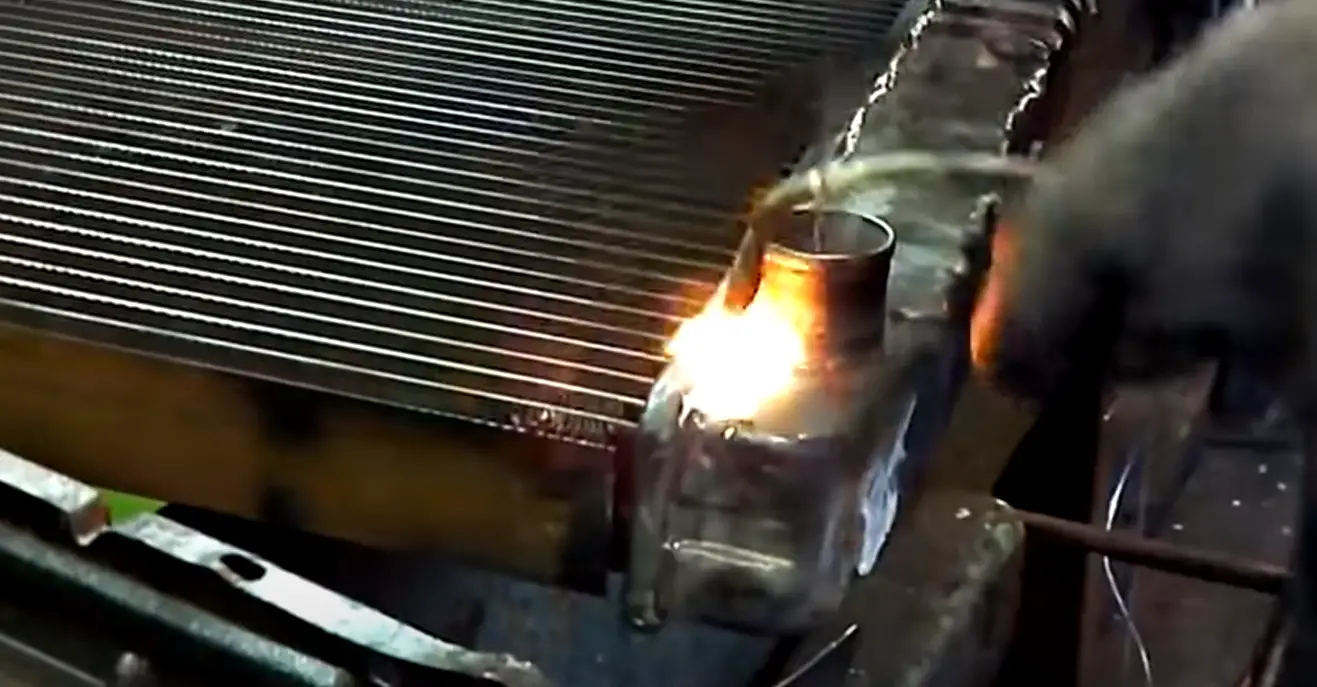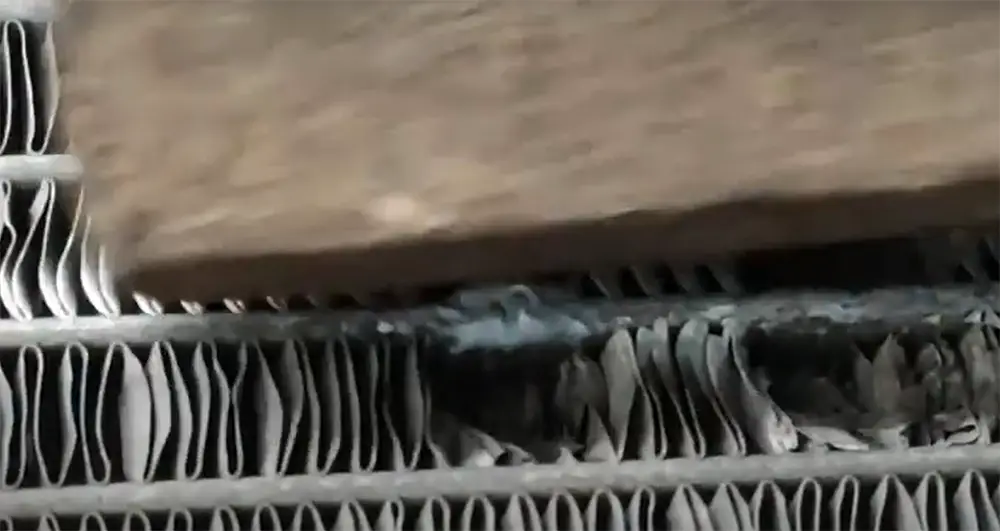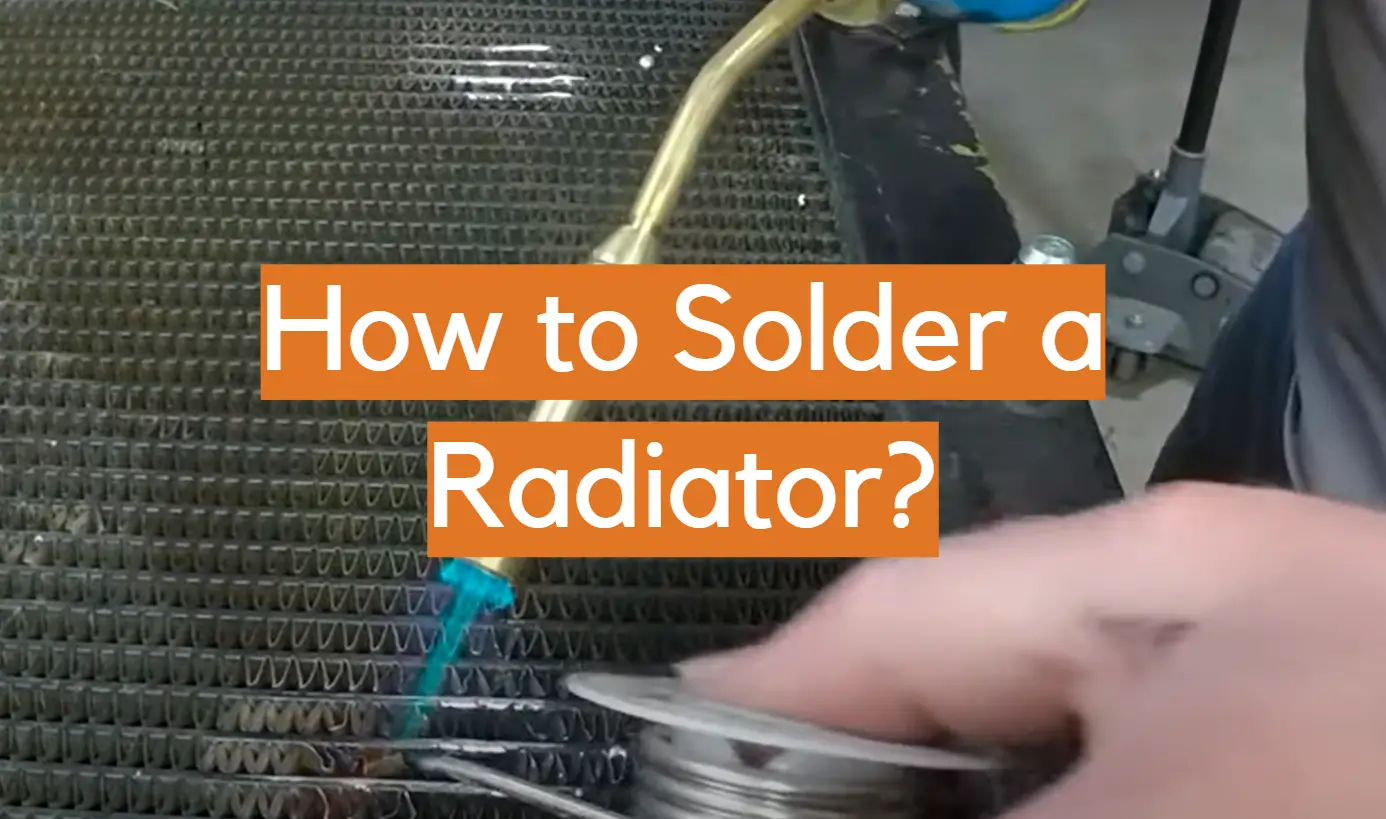Soldering a car radiator is not the easiest task, but if you follow these steps it will be done in no time. This article is for those who are not sure how to solder a radiator. It will provide you with step-by-step instructions on how to do this correctly, as well as some safety tips that can save your life.

Soldering requires very few tools and materials, which means it won’t cost much of anything to get started. Follow the steps below and you’ll be ready to go in no time!
How to Solder a Radiator: Steps
1. Clean the Area to Be Soldered Thoroughly
Before you solder the leak in your automobile’s radiator, make sure the surrounding region is clean and free of obstacles. Make absolutely sure to remove any paint from the leaking radiator with a tiny grinder or steel wire brush before cleaning the area to be soldered.
However, while cleaning the site of sale, keep in mind that you don’t want to inflict any additional damage that might cause the hole or leak to grow larger.

A radiator is almost always composed of softer metals, and it should be simple to clean before soldering. To improve adhesion between the soldering wire and the radiator, use high-quality degreasing or brake cleaner to clean the damaged region on the radiator.
2. Use a High Wattage Soldering Iron and Heavy Wire
Make sure you have a high wattage soldering iron and heavy-gauge, or very thick, soldering wire before you begin. Low-wattage soldering irons will not be able to sufficiently melt the radiator and soldering wire together because they do not produce enough heat. The most common wattage for hobby soldering irons is around 30 watts.
3. Heat the Radiator with the Soldering Iron
When it comes time to repair your leaky radiator, make sure you heat the damaged area first. Hold the soldering iron to the radiator until it is warm enough to accept the solder and wire smoothly. After heating the leaky region of the radiator, slowly insert the wire into it. To avoid leaking afterward, make sure to fully fill any cracks or flaws with enough solder.
4. Grind to a Flat Finish
When removing the damaged portion of a radiator, you must first grind the region to where it is somewhat smooth. You may use a tiny wheel grinder or a steel brush to do this. If any burrs or sharp edges remain in the mended area of the radiator, attempt to remove them while grinding the fractured portion.

It is not necessary to level or flush with the rest of the radiator’s surface when grinding the welded area. The objective is to simply obtain a semi-smooth finish that will endure and prevent dripping from leaking from the radiator.
Comparison of Different Soldering Techniques for Radiators
There are various soldering techniques available, and each technique has its advantages and disadvantages. This table compares different soldering techniques for radiators based on their heat resistance, ease of use, and cost.
| Soldering Technique | Heat Resistance | Ease of Use | Cost |
|---|---|---|---|
| Soft Soldering | Low (up to 400°F) | Easy | Low |
| Hard Soldering | Medium (up to 700°F) | Moderate | Moderate |
| Brazing | High (above 1000°F) | Difficult | High |
Soft soldering is the easiest and cheapest technique for soldering radiators. However, it has low heat resistance and is not suitable for high-pressure systems. Hard soldering provides a better heat resistance than soft soldering and is ideal for moderate-pressure systems. It requires more skill and experience than soft soldering and is slightly more expensive. Brazing is the most difficult and expensive technique but offers the highest heat resistance, making it ideal for high-pressure systems. It requires advanced skills and equipment and is not recommended for inexperienced individuals. When choosing a soldering technique for radiators, it is essential to consider the heat resistance needed for the system, the skill level required, and the cost.
Check more posts about soldering:
FAQ
1. What kind of solder do you use on a radiator?
Some experts recommend using silver solder with a 50/50 tin and lead ratio. It is very important to use the right type of solder for your project, as it will give you optimal results [1].
2. Does soldering a radiator work?
All radiator soldering is permitted. There are no circumstances in which it is dangerous to attach a radiator. If the car is quite old and the cooling system has fallen apart, there’s little hope that soldering will help [2].
3. How do you fix a radiator leak with solder?
To fix a radiator leak with a solder, you will need to remove the old solder. Then clean both surfaces and apply new flux using either a brush or cotton swab before applying your solder. Make sure to heat the radiator until your solder starts to melt, which should only take a few minutes. Remember that you need good ventilation and eye protection when soldering.
4. Can an aluminum radiator be soldered?
Yes. However, it is important to note that lead-free solder should not be used on aluminum because this can cause pitting. You will need a silver soldering flux that contains no more than 50% zinc [3].
5. Can JB Weld fix a radiator?
Yes. It’s a versatile solution for a variety of applications. For example, it can be used as insulating holes in car radiators, washing machine fluid reservoirs, storage containers, water tanks, polymers, composites, PVCs, and more.
6. What is the best way to fix a hole in a radiator?
One of the best ways to fix a hole in your radiator is by using JB Weld. This will require you to clean off the area around it thoroughly with either rubbing alcohol, acetone, or brake cleaner before applying this product.
7. What do you use to weld a radiator?
If you’re welding a radiator, it is important to use lead-free solder that contains silver. This will provide good thermal transfer and corrosion protection.
8. How do you fix a radiator leak fast?
The best way to fix a radiator leak fast is by applying epoxy onto the crack. If it’s still leaking after this, you can try using JB Weld or another plastic-based product.
Repairing this problem may appear to be a difficult task, but it is not:
- Drain your radiator. To accomplish this, make sure your engine has had ample time to cool, your battery is disconnected, and the car is covered with an authorized blanket or tarp to prevent splashing from reaching it. Unscrew the radiator cap to provide circulation and put your container beneath the radiator plug, which is usually found at one of the bottom corners. Remove the plug and allow the fluid to drain until it stops dripping.
- Clean the location of the leak thoroughly. Scrape rust and other debris away if necessary, and make sure any grease, grime, or debris is removed with a rag and a solvent if required.
- Combine the JB Weld ingredients in a plastic mixing dish. Using your wooden tool, combine equal amounts of the black and red tubes on your disposable plastic surface. Work quickly because the JB Weld hardens rapidly.
- All of this will take place in a little container, and you’ll be able to move it anywhere. Apply your mixed JB Weld all over the leak area heavily with the wooden tool. The mixture will be set in 4 to 6 hours and fully cured in 15 to 24 hours.
- Replace the internal radiator plug and add coolant to the proper level. Replace the cap and remove the engine cover you used to keep fluids from going into your engine. Connect your battery back up and turn on your car.
After the automobile has been started, check for still leaks and repeat as needed.
9. How do you temporarily fix a radiator?
Radiators can develop leaks over time, and if you have a radiator that needs to be fixed for the moment but can’t wait for a long-term fix, you will need to temporarily take care of it. Luckily, this can be done in several ways:
- JB Weld One popular option is using epoxy putty like JB Weld (or similar products). However, this solution only lasts up until the paneling has had some time to dry or fully cure. Once everything begins drying out again, your temporary repair may no longer work as well as desired. For those situations where repairs must last much longer than 24 hours before more permanent measures can begin being taken (such as fixing the wall around the radiator) an alternative would be considered instead;
- Duct tape. One such alternative is using duct tape, which can hold your radiator in place quite well and prevent any leaks from occurring. This solution will also last much longer than 24 hours without losing its adhesive strength or breaking down for similar reasons to epoxy putty;
Both of these options are great for temporary fixes on the spot when you have no other means of maintaining a functional radiator until it can be repaired properly. If you do not need an immediate fix, however, there are some more sophisticated alternatives available as well that may suit certain needs better depending upon their current situation.
Useful Video: Soldering a forklift radiator
References:
- http://files.aws.org/wj/supplement/WJ_1972_06_s295.pdf
- https://www.carsdirect.com/car-repair/radiator-repair-3-soldering-tips-for-proper-restoration
- https://superiorflux.com/techniques-for-soldering-aluminum/














When I had to deal with leaks in my radiator I’d used the Permatex Quick Solder radiator repair kit. While being quite pricey, this kit is still a lot cheaper than getting your car towed to the mechanic. The kit includes a resin-impregnated fiber patch and two tubes of quick setting steel-reinforced epoxy putty.
I’ve used this Permatex kit on several occasions with great results. Not only does it work well, but it’s also very easy to use.
I’ve also found that this Permatex kit is good for small to medium leaks. For larger leaks, or for those that are difficult to access, I’d recommend you resort to welding instead. Better be safe than sorry!